How to Make 100% Whole Wheat Sourdough Bread
This post may contain affiliate links. As an Amazon Associate, I may receive a small commission, at no cost to you, if you make a purchase. Please read our disclosure policy.
Learn how simple it is to make 100% whole wheat sourdough bread at home with step-by-step instructions. This whole wheat sourdough bread recipe is simple and straightforward, with just 4 simple ingredients, to produce a delicious, wholesome loaf right at home.
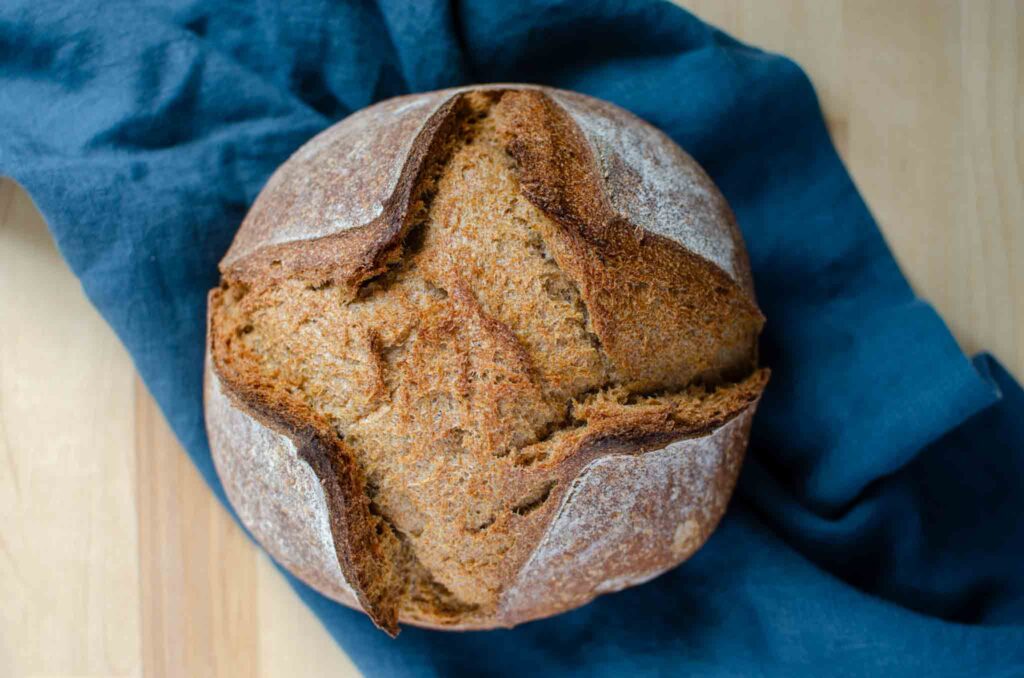
100% whole wheat sourdough bread has a hearty, nutty flavor with a tight crumb that has a slightly chewy texture. Most whole wheat sourdough bread recipes vary on the ratio of whole wheat flour to white flour, finding a balance between enough whole wheat flour for added goodness and flavor and all-purpose flour to achieve a lighter texture and a taller rise. This 100% whole wheat sourdough recipe is different than a whole wheat white bread recipe and will produce a hefty, dense loaf.
What is Whole Wheat Bread?
Simply put, whole wheat bread uses whole wheat flour instead of an all purpose or white bread flour. Whole wheat flour starts as a wheat kernel that is stripped of its outer shell, leaving the edible part behind called a wheat berry. This comprises the bran, the germ, and the endosperm, all of which are included in whole wheat flour. These parts have healthy fats, vitamins, minerals, and antioxidants. The largest part of the grain is the endosperm which is full of starchy carbs. In most cases, white flours mostly consist of the endosperm.
Many whole wheat breads found in grocery stores will have varying ratios of whole wheat flour to white flour. A well crafted balance of whole wheat flour for the health benefits, but relying on all-purpose flour or bread flour to help with lift and lighten the texture of the loaf.
100% Whole Wheat Sourdough Bread Ingredients
- Whole wheat flour – There is such a range of the types of whole wheat flour you can use with as much variety in how you get it. The simplest way to source whole wheat flour is to buy a bag from your local grocery store. However if you have a grain mill, you now have the ability to grind wheat berries, ranging from hard to soft, red or white, for fresh stone-milled flour. I don’t have a grain mill so I just opt to buy my flour from the store and still make beautiful loaves of bread.
- Sourdough starter – Use active starter that has been fed and allowed to rise to it’s peak.
- Water – Using warm water encourages fermentation activity.
- Salt – Adds flavor to your bread.
Step-By-Step Instructions For 100% Whole Wheat Sourdough Bread
Prepare
Most people don’t keep a separate whole wheat starter but its easy to make a whole wheat levain using a small portion of any starter.
Add 36 g of unfed sourdough starter to a clean container, I like to use a mason jar. Mix equal parts water and whole wheat flour, 36 grams each, to the jar.
Cover the top of the jar with a napkin and rubber band.
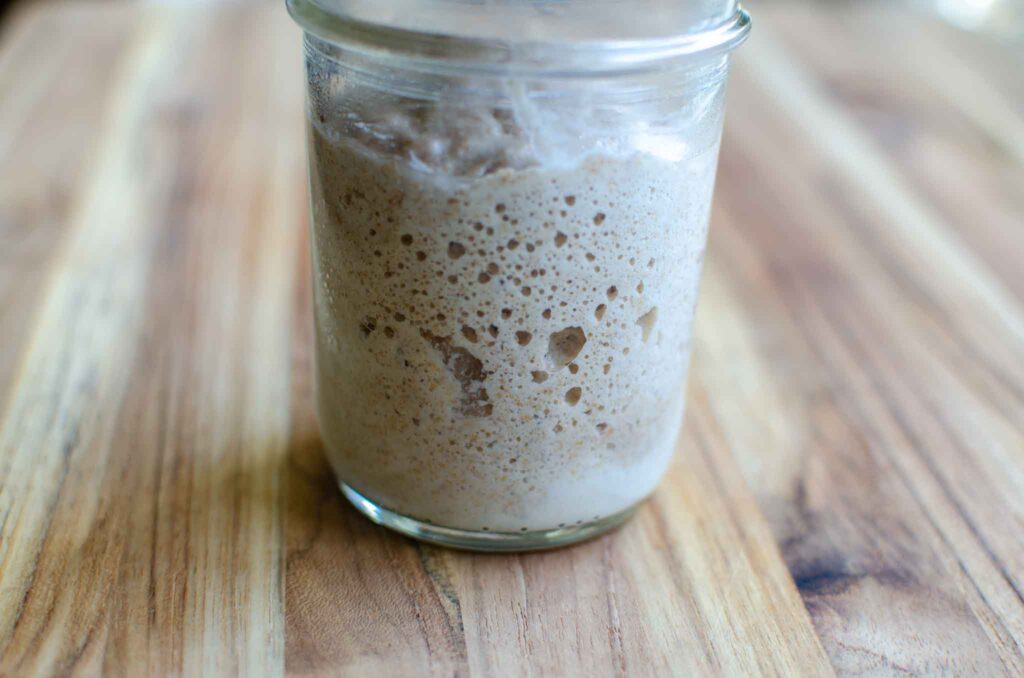
Mix the Dough
Add sourdough starter, 350 g of water, and whole wheat flour in a large bowl and thoroughly combine using a dough whisk. Let the dough rest for 30 minutes at room temperature so the whole wheat flour can properly hydrate.
Combine the remaining 25 g of water and salt in a small bowl. Pour over the top of the dough and mix it in completely. I’ve found the best way to incorporate the water into the dough is by squeezing and folding the dough. Then let the dough rest for 30 minutes.
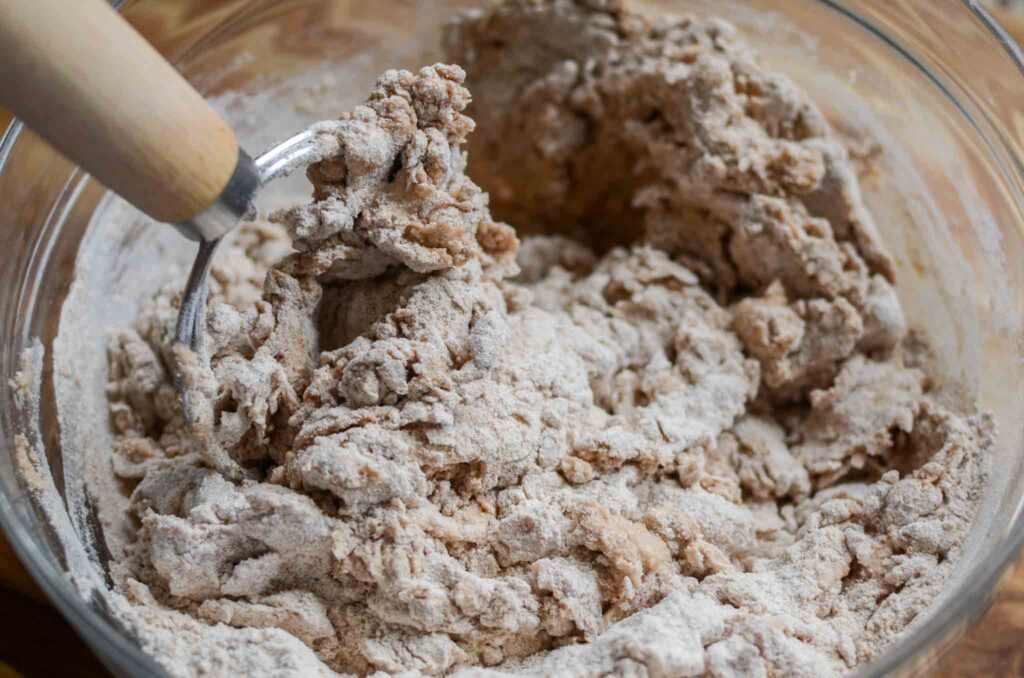
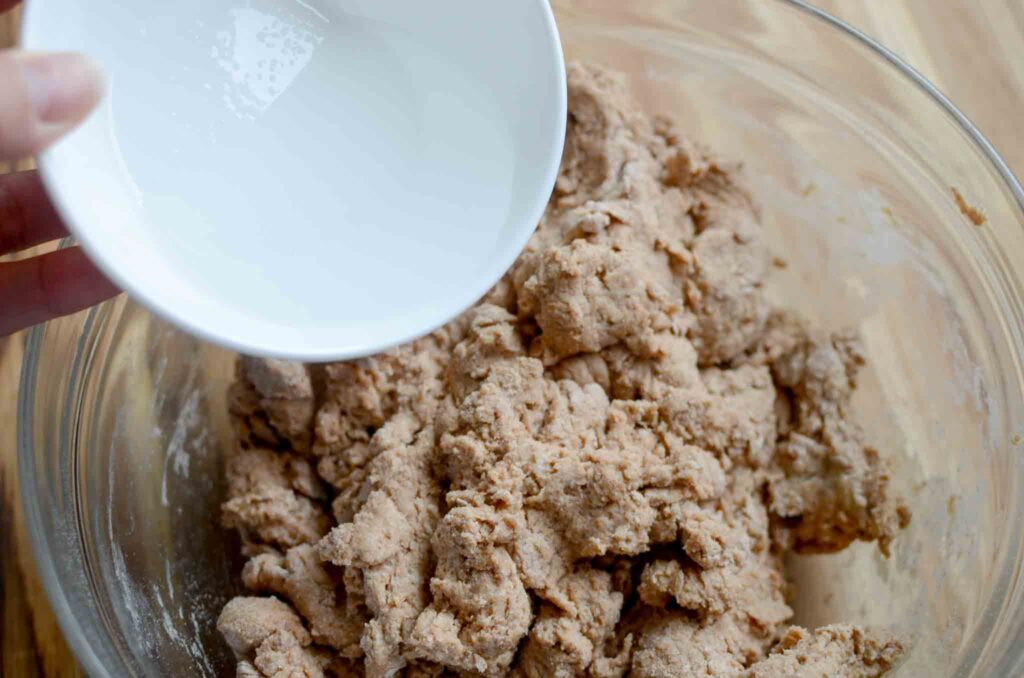
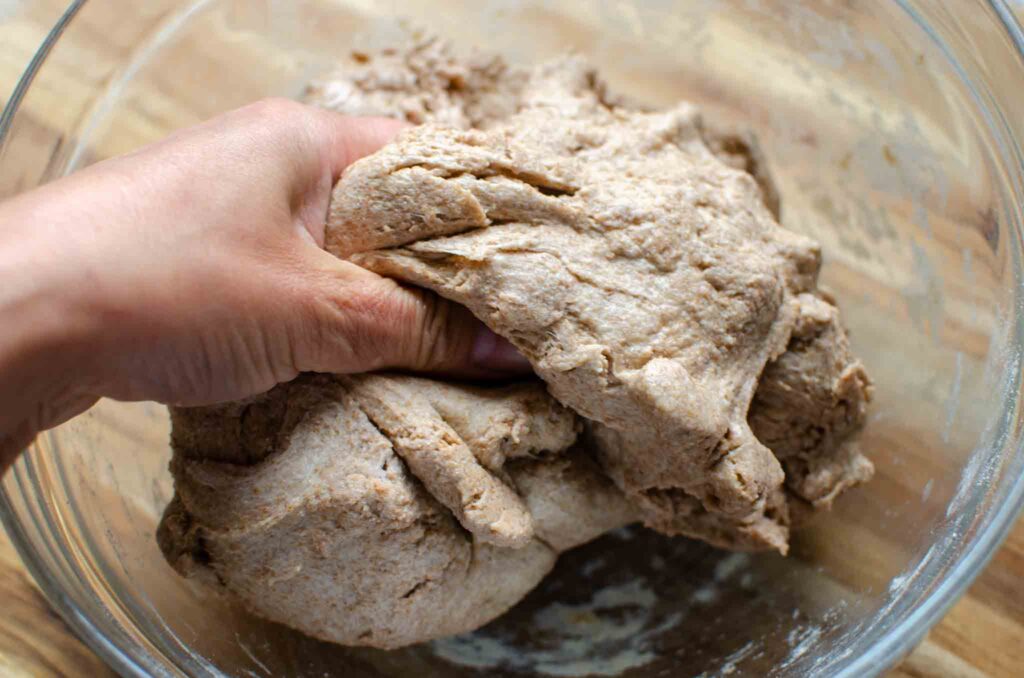
Stretch and Folds
The whole wheat dough will go through 3 sets of stretch and folds over the next 2 hours.
Grab the edge of the dough and lift it straight up to stretch it, then fold it over onto itself in the middle of the dough. Turn the bowl a quarter of a turn and repeat, stretching and folding the dough.
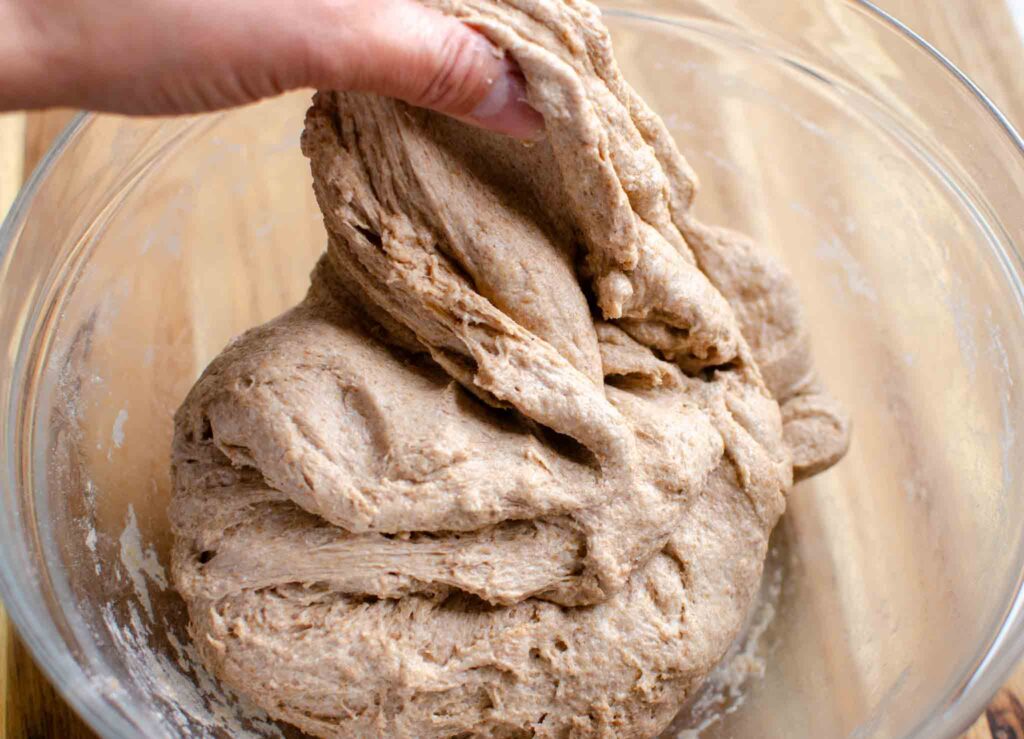
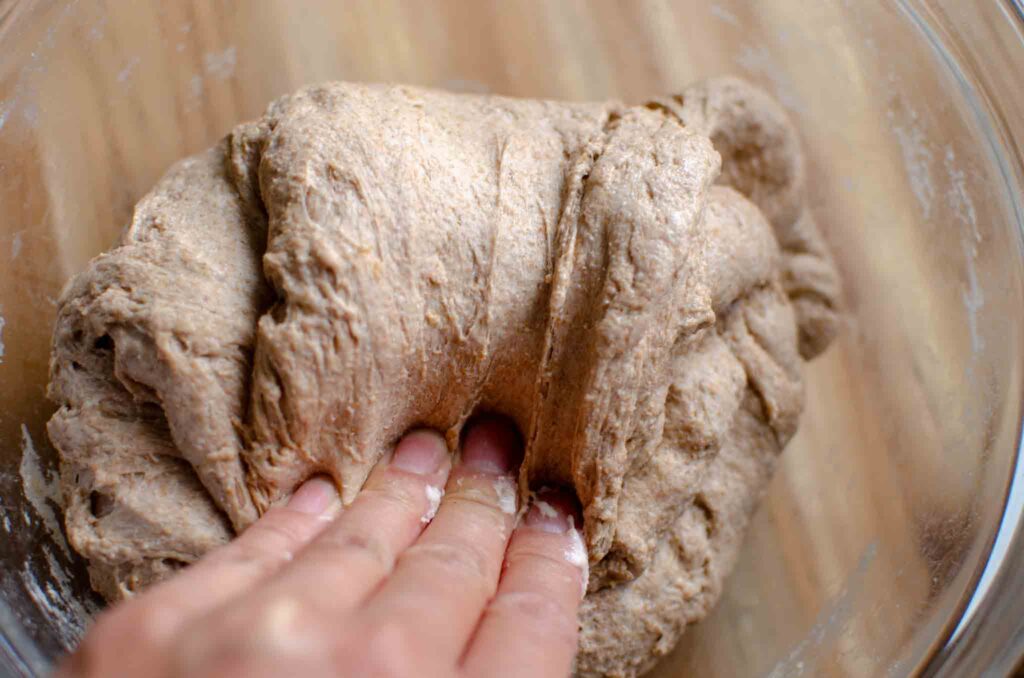
Continue working your way around the sides of the bowl, working the dough until it becomes tight and resistant. This completes one set of stretch and folds. Wait 30 minutes and do another set. Continue until you complete 3 sets of stretch and folds with 30 minute increments.
Bulk Fermentation
Cover the bowl and let the dough rise in a warm place until it increases by 50 percent. The length of the fermentation process can vary depending on the temperature of your kitchen but generally this takes 5-6 hours.
Shape
Once the dough has risen turn the dough out onto a lightly floured work surface. Shape the dough using the envelope fold. First, fold the top of the dough down to the middle. Then, fold the bottom of the dough up to meet the other fold in the middle of the dough. Continue to fold each side inward to the middle.
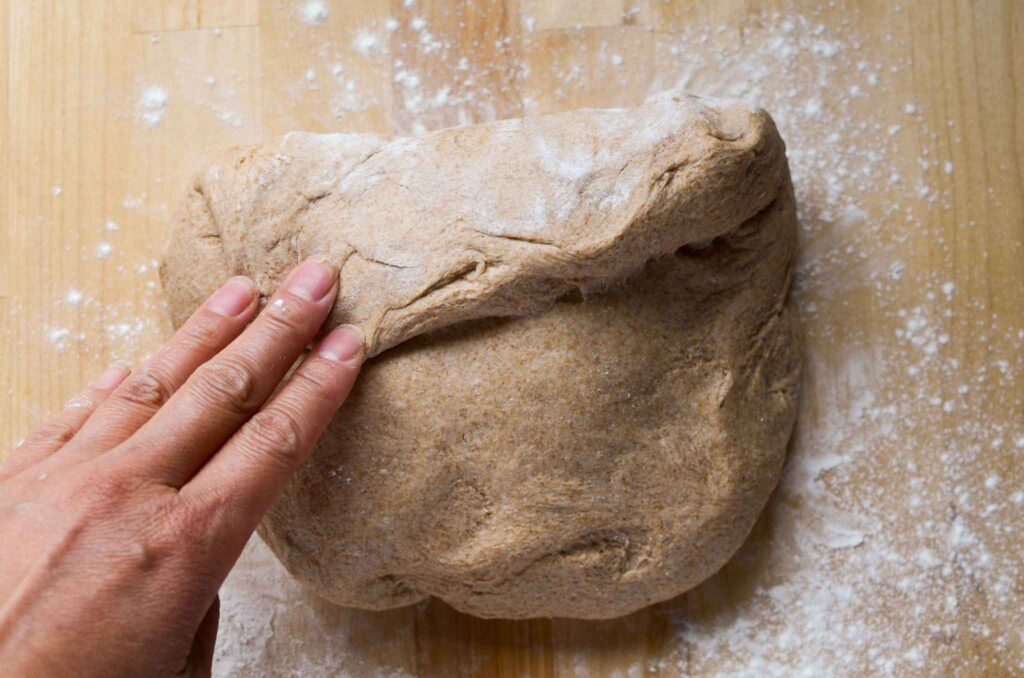
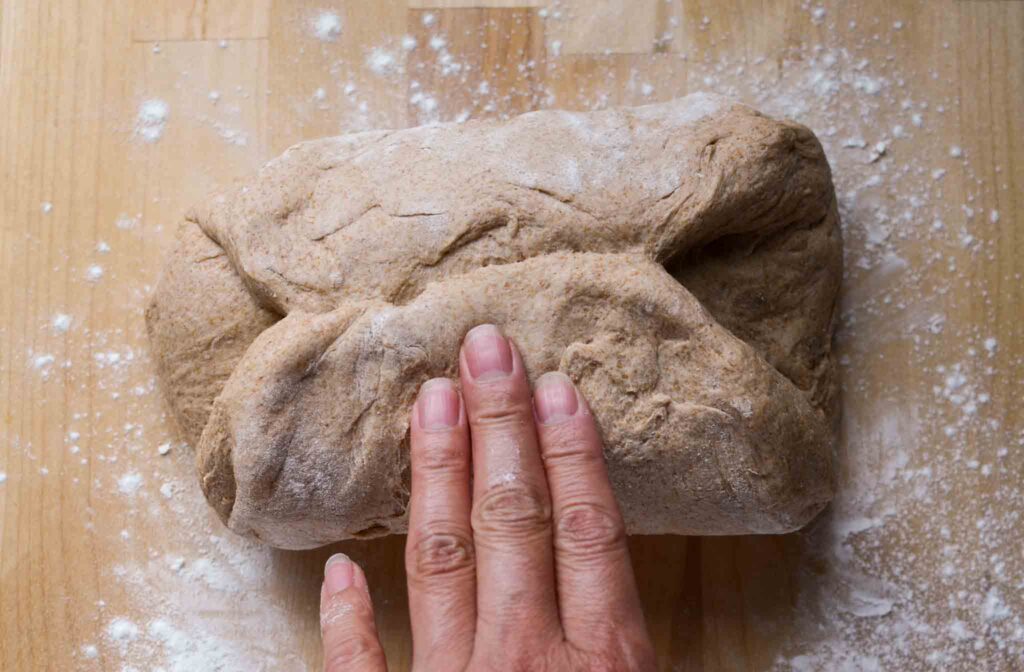
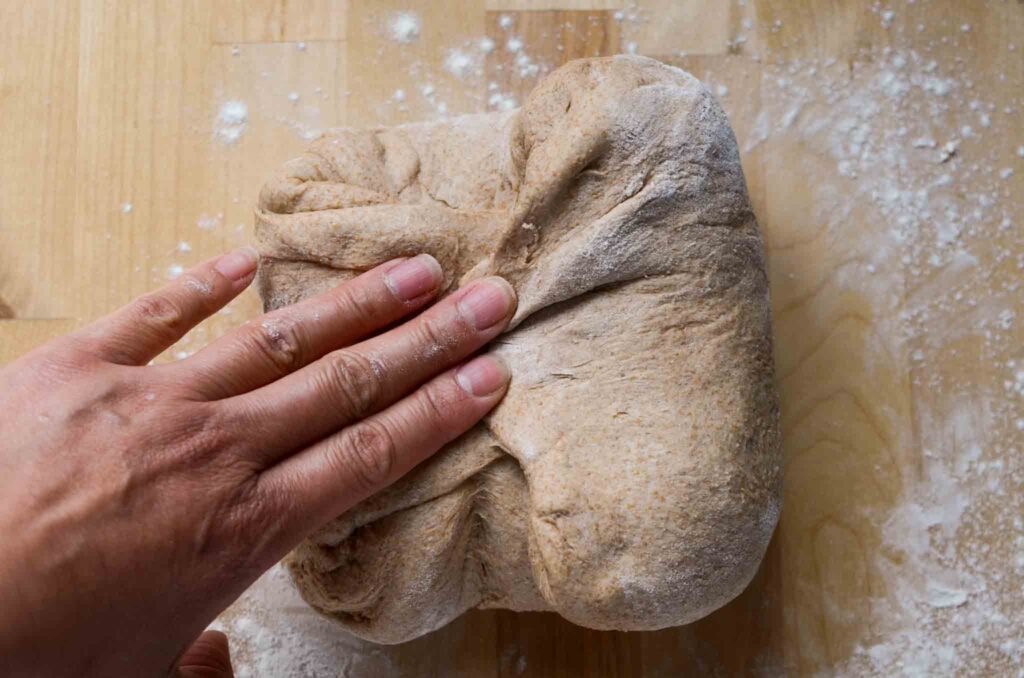
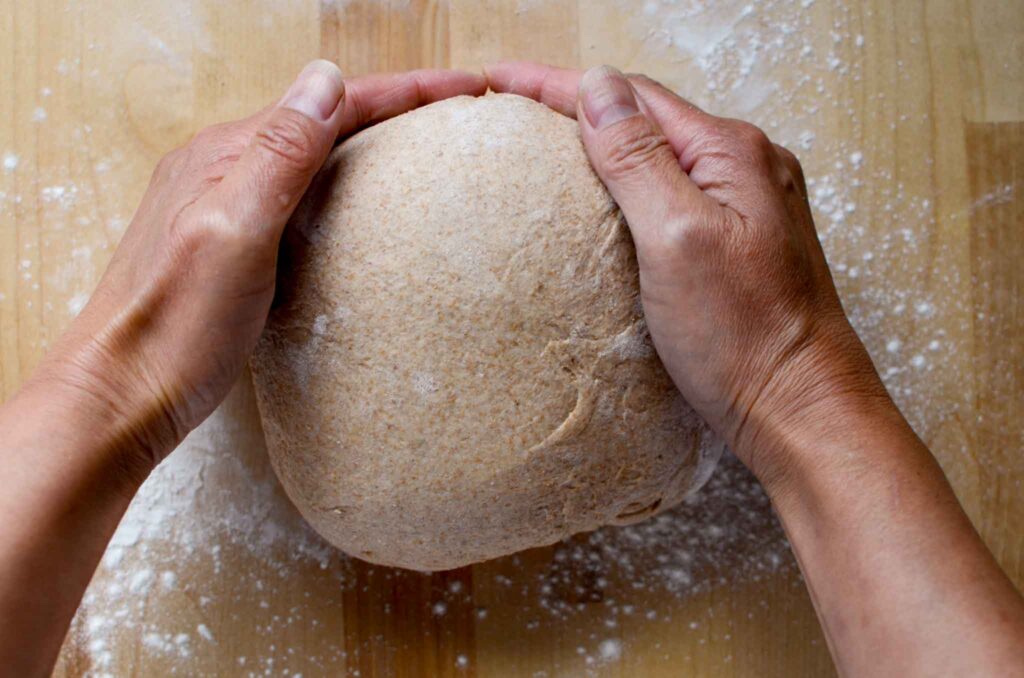
Flip the dough over with a bench scraper so that the folds are facing down. With two hands cupping the far side of the dough, gently pull the dough towards you, pressing your hands slightly under to create some tension on the top of the loaf. Continue to pull the bread dough, slightly pivoting your starting point until the loaf is a smooth, round shape.
Lightly dust a banneton with rice flour and place the dough upside down with the seams facing up. Don’t worry if you don’t have a banneton, you can use a large bowl and a piece of parchment paper instead. Lift the dough onto a piece of parchment paper with the seam facing down and then using the parchment paper as the handles, lift the dough into the bowl.
Second Ferment
Cover the bowl or banneton and allow it to sit at room temperature for another hour after shaping before moving to the refrigerator.
The second ferment, sometimes referred to as a proofing stage, helps the dough develop that classic sourdough tang as well as creates a blistered crust.
Bake
The following morning preheat a Dutch oven and lid to 450 degrees for 30-45 minutes. Cold sourdough bread dough will have a better oven spring when it hits a high temperature, creating a taller loaf.
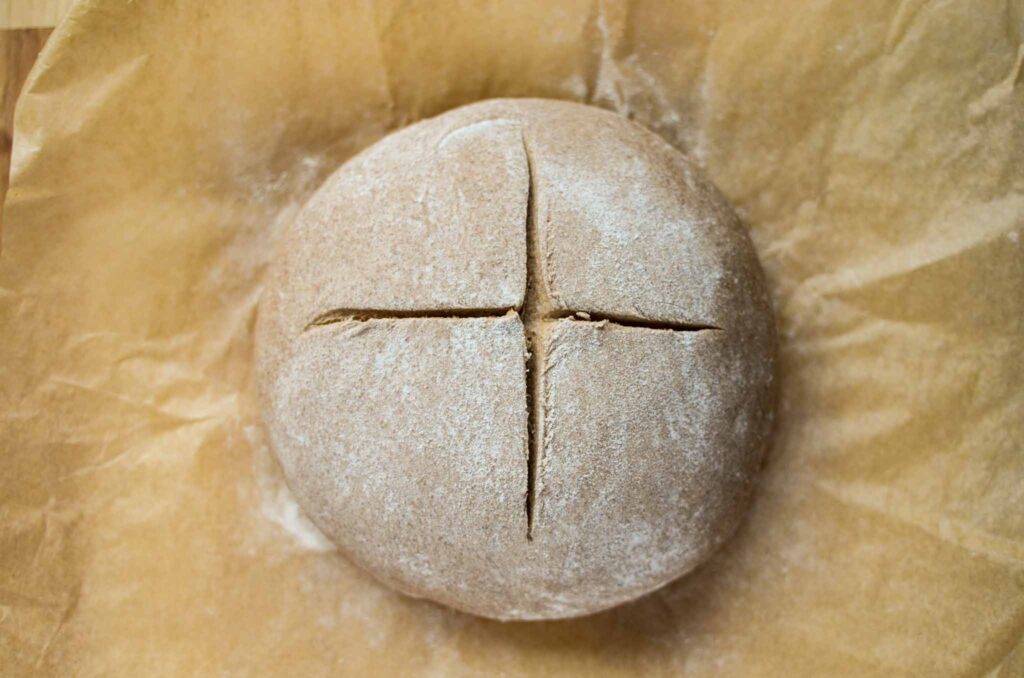
Remove the bread dough from the fridge and score a long slash on the top of the dough with a razor blade or lame. This gives the bread a controlled place to expand in the oven. Using the parchment paper, lift the bread dough into the preheated Dutch oven and bake for 35 minutes with the lid. Remove the lid and bake for an additional 20 minutes.
Knowing when the bread is done by looks alone is difficult due to its dark color. The bread is done when the bottom of the loaf is tapped and it sounds hollow, indicating that the majority of the moisture is gone. It continues to release additional moisture as it cools as the internal structure needs time to set properly. The bread is done baking when an internal temperature reaches 200 degrees.
Remove the bread from the Dutch oven and place on a wire rack to cool completely before slicing.
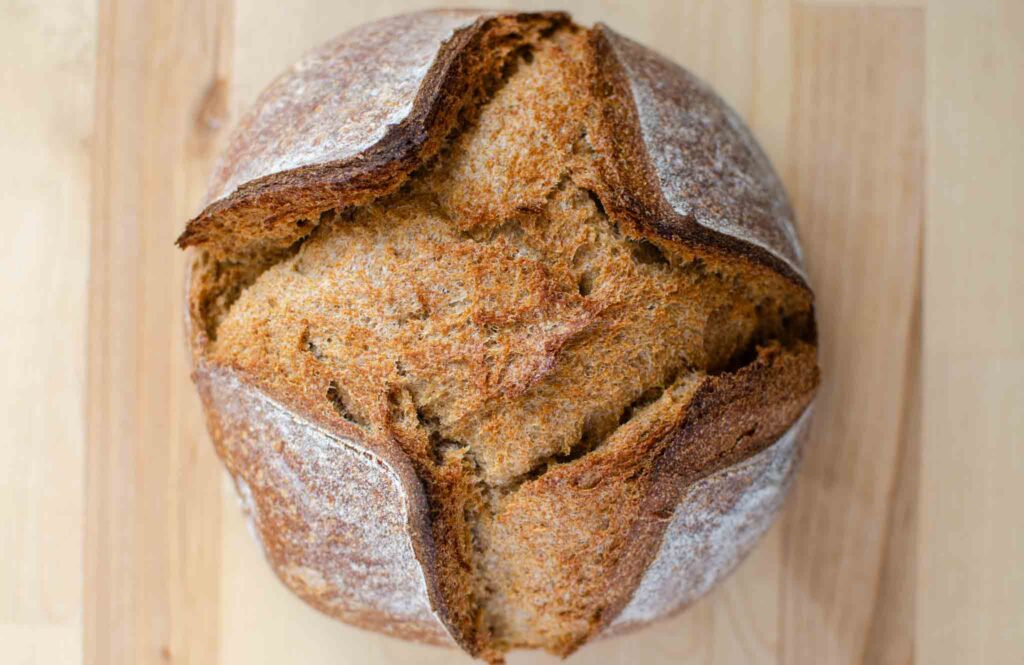
Storage
Place bread in an airtight container and store at room temperature for up to 5 days.
FAQs and Notes
Why Doesn’t 100% Whole Wheat Sourdough Bread Rise Much?
If you’ve eaten a slice of 100% whole wheat bread you’ll notice a huge difference compared to a traditional piece of white bread. Whole wheat flour contains much less gluten compared to white all-purpose flour affecting how much the bread rises. Gluten provides structure to the dough while also making it elastic and easily stretched before breaking, giving the bread a chewy, light texture.
Sourdough Whole Wheat Bread Without Sugar
Sugar can play an important role in bread making aside from just flavor. Just like salt, sugar acts as a preservative against mold growing and will extend the life of your bread. Sugar is hygroscopic, meaning it attracts and retains moisture. When added to bread dough, even after the bread cools, it retains the moisture for a soft and moist bread. To better illustrate this, compare how soft and tender a Hawaiian sweet roll is compared to how dense whole wheat bread is.
A bread recipe made without sugar will have a different texture and flavor and is delicious but it’s good to set your expectations properly.
100% Whole Wheat Bread and Blood Sugar
Since all of the wheat kernel is added to the whole wheat bread, it’s full of fiber which takes longer to digest, reducing the overall spike in blood sugar after eating. Choosing whole grain flours over refined grains can help maintain optimal blood sugar readings. While there are many factors to consider, eating whole wheat sourdough bread reduces the glycemic index by quite a bit (the rate at which the carbs convert into glucose and how much they affect blood sugar levels). This is great news for those watching their blood sugar.
What’s The Difference Between Whole Wheat and Whole Grain?
Whole grain sourdough bread is full of various whole grains such as oats, rice, bulgar, rye, millet, and quinoa, but can be made using whole wheat flour, white flour, or a blend of the two. Whole wheat bread refers to the type of flour you use to make the bread.
Aside from the health benefits of whole wheat bread, many people desire fresh milled flour. Using a grain mill to grins whole wheat berries for the home baker allows you to bake with flours at their peak nutritional level.
Sample Baking Schedule
Day 1
- 8 am – Prepare the levain, also referred to feeding the starter
- 12 pm – The levain is ripe, mix the dough
- 12:30 am – Add salted water
- 1 pm – First set of stretch and folds
- 1:30 pm – Second set of stretch and folds
- 2 pm – Last set of stretch and folds
- 2:10 pm – Bulk ferment
- 8 pm – Shape bread dough
- 8:10 pm – Let rise at room temperature
- 9:10 pm – Cover and refrigerate
Day 2
- 7 am – Preheat Dutch oven
- 7:45 am – Score bread dough and bake
- 8:30 am – Bread is done baking. Allow to cool on wire rack.
I’d love to hear from you! Please leave a comment and rate the recipe. Tag photos #Lockremhomestead over on Instagram when you share pictures of your 100% Whole Wheat Sourdough Bread!
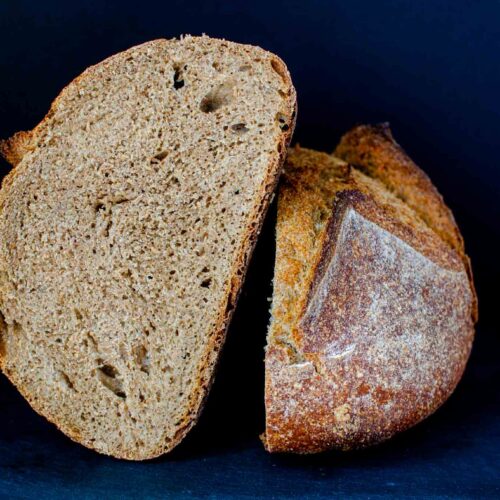
How to Make 100% Whole Wheat Sourdough Bread
Want to Save This Recipe?
Enter your email & I’ll send it to your inbox. Plus, get great new recipes from me every week!
By submitting this form, you consent to receive emails from Lockrem Homestead
Ingredients
Whole Wheat Levain
- 36 g sourdough starter
- 36 g warm water
- 36 g whole wheat flour
Autolyse
- 100 g active sourdough starter (the entire levain)
- 350 g warm water
- 500 g whole wheat flour
Salt/Water
- 25 g warm water
- 10 g salt
Instructions
Levain
- Add 36 g of sourdough starter to a clean container like a mason jar. Mix equal parts water and whole wheat flour, 36 grams each, to the jar. Cover the top of the jar with a napkin and rubber band.
Mixing the Dough
- When the levain is ripe and full of bubbles, add the sourdough starter, 350 g of water, and whole wheat flour in a large bowl.
- Let the dough rest for 30 minutes at room temperature so the whole wheat flour can properly hydrate.
- Combine the remaining 25 g of water and salt in a small bowl. Pour over the top of the dough and mix it in completely. I've found the best way to incorporate the water into the dough is by squeezing and folding the dough. Then let the dough rest for 30 minutes.
Stretch and Folds
- Grab the edge of the dough and lift it straight up to stretch it, then fold it over onto itself in the middle of the dough. Turn the bowl a quarter of a turn and repeat, stretching and folding the dough.
- Continue working your way around the sides of the bowl, working the dough until it becomes tight and resistant. This completes one set of stretch and folds.
- Wait 30 minutes and do another set. Continue until you complete 3 sets of stretch and folds with 30 minute increments.
Bulk Fermentation
- Cover the bowl and let the dough rise in a warm place until it increases by 50 percent. This generally takes 5-6 hours but can vary depending on the temperature of the kitchen.
Shape
- Turn the dough out onto a lightly floured work surface.
- Shape the dough using the envelope fold. First, fold the top of the dough down to the middle. Then, fold the bottom of the dough up to meet the other fold in the middle of the dough. Continue to fold each side inward to the middle.
- Flip the dough over with a bench scraper so that the folds are facing down. With two hands cupping the far side of the dough, gently pull the dough towards you, pressing your hands slightly under to create some tension on the top of the loaf. Continue to pull the bread dough, slightly pivoting your starting point until the loaf is a smooth, round shape.
- Light dust a banneton with rice flour and place the dough upside down with the seams facing up. Don't worry if you don't have a banneton, you can use a large bowl and a piece of parchment paper instead. Lift the dough onto a piece of parchment paper with the seam facing down and then using the parchment paper as the handles, lift the dough into the bowl.
Second Ferment
- Cover the bowl or banneton and allow it to sit at room temperature for another hour after shaping before moving to the refrigerator.
Bake
- The following morning preheat a Dutch oven and lid to 450 degrees for 30-45 minutes.
- Remove the bread dough from the fridge and score a long slash on the top of the dough with a razor blade or lame.
- Using the parchment paper, lift the bread dough into the preheated Dutch oven and bake for 35 minutes with the lid. Remove the lid and bake for an additional 20 minutes.Knowing when the bread is done by looks alone is difficult due to its dark color. The bread is done when the bottom of the loaf is tapped and it sounds hollow, indicating that the majority of the moisture is gone. The bread is done baking when an internal temperature reaches 200 degrees.
- Remove the bread from the Dutch oven and place on a wire rack to cool completely before slicing.
Storage
- Place bread in an airtight container and store at room temperature for up to 5 days.

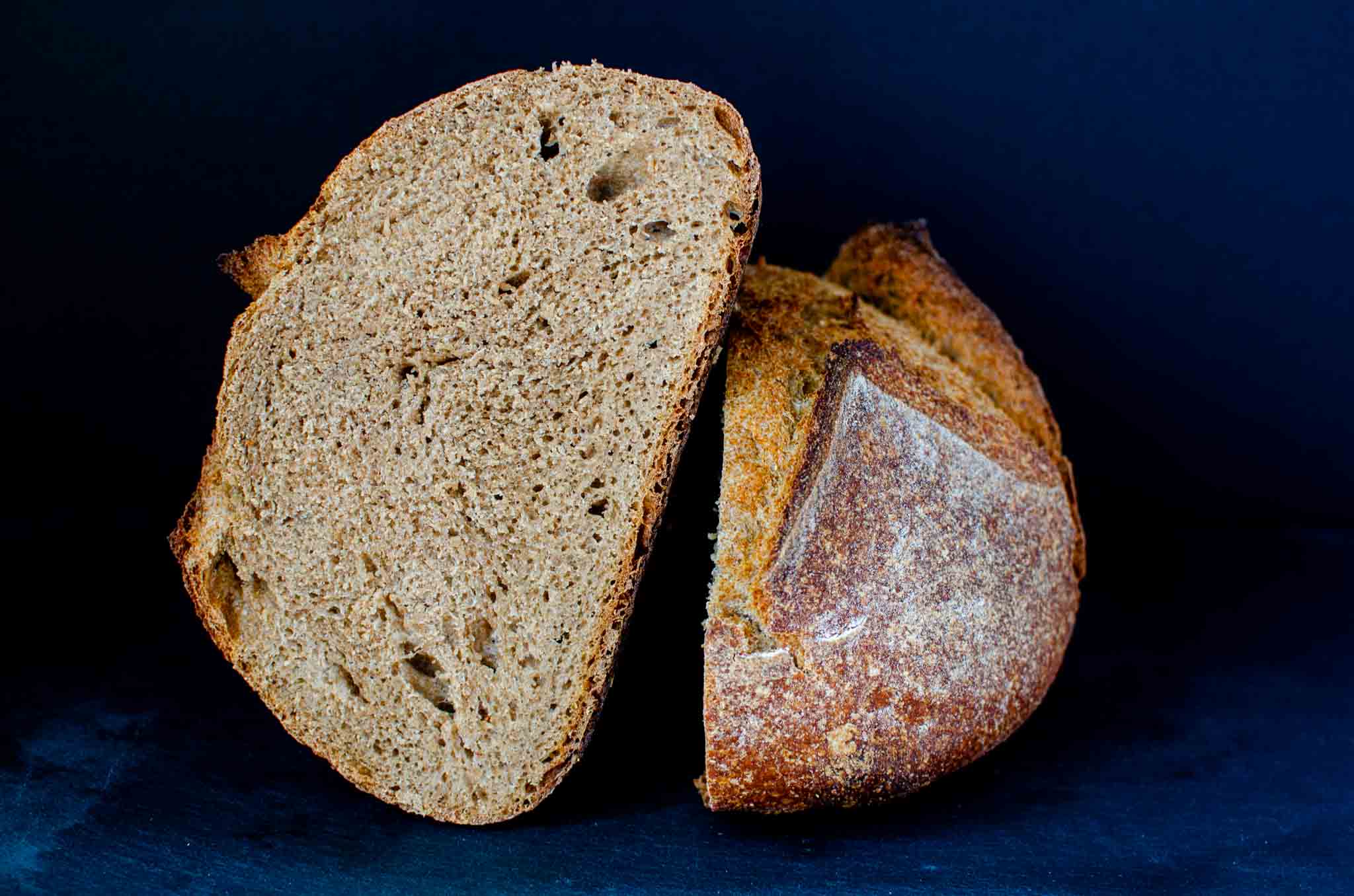
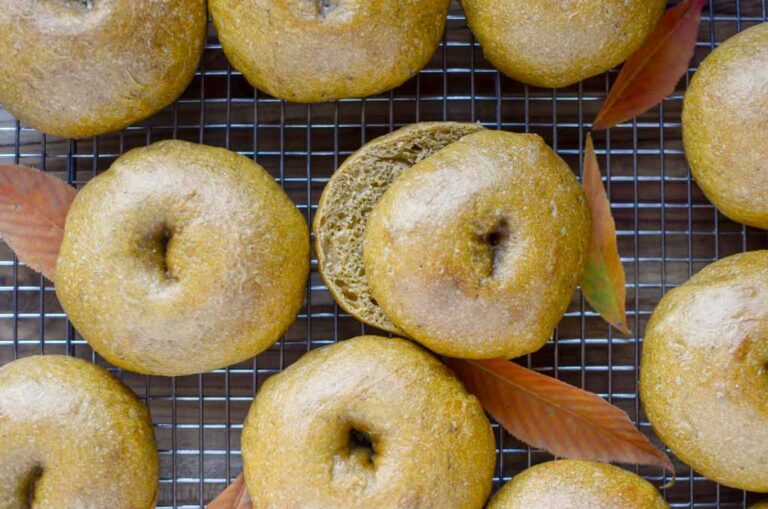

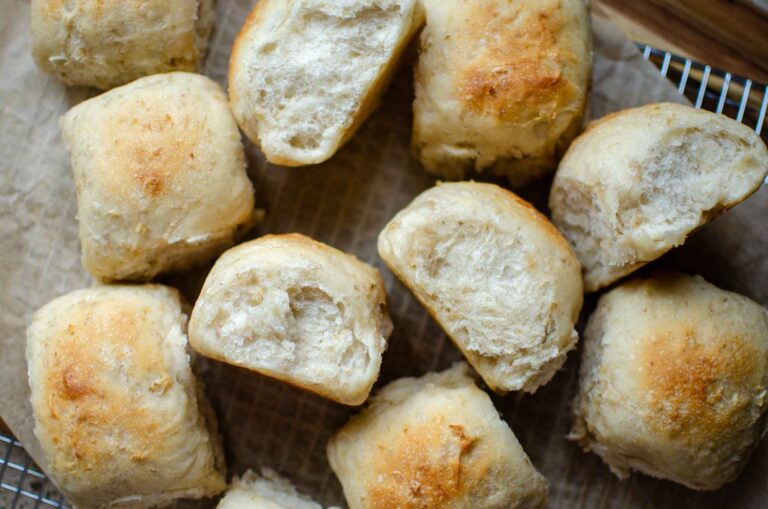
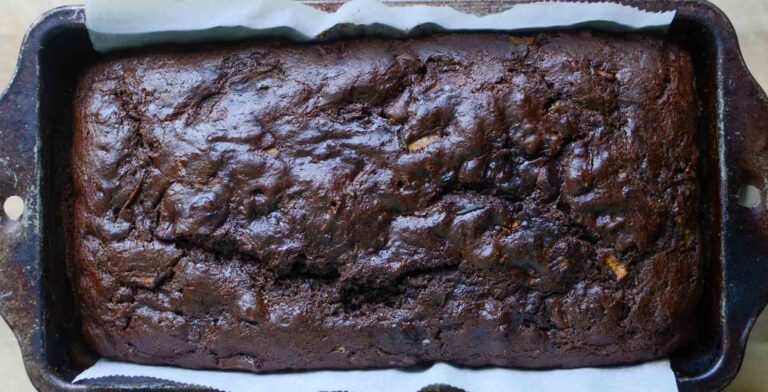
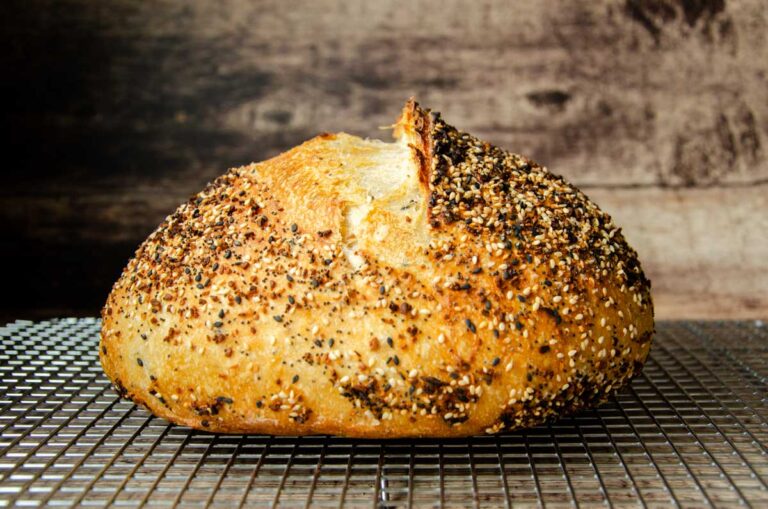

I know you’re going to LOVE this recipe! It’s one of our family favorites. Plus, don’t forget that you can leave a comment or ask me a question here, and I’ll get back to you!